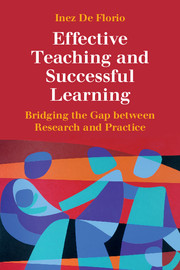Book contents
- Frontmatter
- Epigraph
- Contents
- Preface
- Introduction
- 1 Main Features of Scientific Research on Education
- 2 Important Types of Scientific Research on Education
- 3 Main Features of Evidence-based Research on Education
- 4 Meta-Analyses on Education
- 5 A Synthesis of Over 800 Meta-Analyses Relating to Achievement
- 6 Scaffolding Effective Teaching and Successful Learning
- 7 Planning and Starting the Lesson
- 8 Presenting Knowledge and Skills – Assertive Questioning
- 9 Guided and Independent Practice
- 10 Cooperative and Project-based Learning
- 11 Feedback – Reciprocal and Informative
- Concluding Remarks: Standards Need More Evidence
- References
- Index
7 - Planning and Starting the Lesson
Published online by Cambridge University Press: 05 June 2016
- Frontmatter
- Epigraph
- Contents
- Preface
- Introduction
- 1 Main Features of Scientific Research on Education
- 2 Important Types of Scientific Research on Education
- 3 Main Features of Evidence-based Research on Education
- 4 Meta-Analyses on Education
- 5 A Synthesis of Over 800 Meta-Analyses Relating to Achievement
- 6 Scaffolding Effective Teaching and Successful Learning
- 7 Planning and Starting the Lesson
- 8 Presenting Knowledge and Skills – Assertive Questioning
- 9 Guided and Independent Practice
- 10 Cooperative and Project-based Learning
- 11 Feedback – Reciprocal and Informative
- Concluding Remarks: Standards Need More Evidence
- References
- Index
Summary
Finally we get to practice, some of you might be thinking. In some ways you are right, because in the following chapters we will find out in what ways we can concretize the single steps of the Model of Effective Teaching (MET) for your teaching. As my model does not apply to a particular school system but should be open to teachers all over the world aiming at improving their classroom practice, the following examples do not refer to a special curriculum. But I am confident that my examples can be adopted and adapted to many teaching and learning contexts. Above all, they are presented to show what it means to be a teacher. Furthermore, no proposal can be transferred one-to-one. Even if you want to apply a new teaching strategy proposed by a colleague who works in a comparable context, you have to look for adaptation. Every intervention program and every teaching strategy or technique call for changes in order to reach the individual learners. Or do you use your textbooks like programmed instruction?
Before starting with explanations and examples of how to plan and start a lesson or a teaching unit, we will do what you are expected to do with your learners. How can you as a teacher relate to the knowledge you – hopefully – have acquired during the previous Chapters 1–6? We will do so consulting the Sutton Report of October 2014. I have chosen the research results of Rob Coe and colleagues of Durham University, U.K., in order to show you that reviewing is more effective when it does not consist of simple repetition, but offers food for further thought.
In general you are right when you expect more concrete considerations, but, nevertheless, they are based on theory, or, better, on various theoretical foundations. Thoughtful practice is always grounded in theory. Think of the following example. You want your students to summarize an experiment you have conducted in class in one of the most recent lessons. You hesitate to invite your learners to summarize it in written form because you have doubts that they well remember all important details. You reflect on what to do: Should you carry out the experiment again? What about revising the important features in the form of Interactive Whole-class Teaching, giving all students an opportunity to recall the experiment? What if you summarize it yourself?
- Type
- Chapter
- Information
- Effective Teaching and Successful LearningBridging the Gap between Research and Practice, pp. 118 - 136Publisher: Cambridge University PressPrint publication year: 2016



